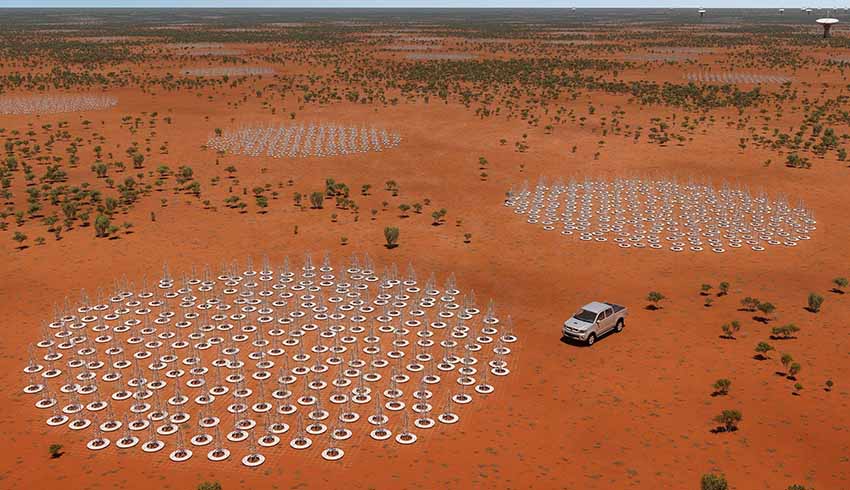Pawsey’s new system will be built using the HPE Cray EX supercomputer, with expanded data storage capabilities through the Cray ClusterStor E1000 system, significantly increased compute power and more emphasis on accelerators with future-generation AMD EPYC CPUs and AMD Instinct GPUs.
The new supercomputer will be at least 10 times more power efficient than its predecessors Magnus and Galaxy. For the 30-fold increase in computing power, Pawsey expects the new system’s energy requirements will only increase by 50 per cent once the system is fully commissioned.
Today, more than 1,600 researchers use Pawsey’s supercomputers directly to support their computing-intensive projects, including discovering new galaxies, developing improved diagnostic tests for coronaviruses, and finding AI-enabled ways to reduce herbicide use.
Mark Stickells, director of the Pawsey Supercomputing Centre, said the new system will help propel the position of Australian research on the global stage, explaining, "Supercomputers like those at Pawsey are increasingly crucial to our ability to conduct world-class, high-impact research. The upgrades we’re announcing are a critical move in strengthening Australia’s position in the global research environment and playing a part in major global research projects, from helping in the fight against COVID-19 to working with the precursor telescopes to the Square Kilometre Array."
John Langoulant, chairman at Pawsey Supercomputing Centre, echoed the impact of the new supercomputer for the state, the country, and the world.
"Today’s supercomputer upgrade will significantly boost the national effort, elevating the role of Australian research on the global stage and creating opportunities for new high-impact research that benefits Western Australia, the nation and the world," Langoulant said.
The new supercomputer will help meet the exponentially increasing computing needs of Australian researchers in fields such as medicine, artificial intelligence, radio astronomy and more.
Dr Chenoa Tremblay, postdoctoral fellow in dark magnetism at CSIRO, is using Pawsey’s existing supercomputing systems to analyse extremely sensitive radio telescope signals that could give us our first potential evidence of life outside our solar system. Her team’s work requires scanning more than 10 million stars and analysing hundreds of terabytes of data, a herculean task that will be accelerated with the new supercomputer.
"Doing this on my laptop would take 25 years. Pawsey’s supercomputing systems have brought some of our research timelines from years down to days, giving us the power we need to analyse hundreds of thousands of images quickly. With the signals being very weak, finding new ones will require even more data to crunch," Dr Tremblay explained.
Nick Gorga, general manager, HPC and AI, APAC-India at HPE, added, "Scientific breakthroughs made by leading research centres, such as Pawsey Supercomputer Centre, inspire us to continue empowering the community with powerful supercomputing solutions that combat the broadest range of challenges."
The new supercomputer is part of Pawsey’s Capital Refresh Program, which is being delivered under a $70 million grant from the Australian government announced in 2018 to upgrade Pawsey’s supercomputing infrastructure. This is in addition to the $80 million granted in 2009 to establish the petascale supercomputing facility.
In 2018, the Australian government awarded $70 million to upgrade Pawsey’s supercomputing infrastructure, on top of the $80 million granted in 2009 to establish a petascale supercomputing facility. The Pawsey upgrade, as a major part of the national HPC infrastructure, is ensuring Australia continues to enable computationally-intense research.
Pawsey capital refresh is a complex upgrade will be a staged process. Some ancillary systems, including storage and network infrastructure, have been procured prior to the main system.
The new MWA Compute Cluster is named “Garrawarla”, meaning spider in the Wajarri language; whose land the Murchison Radio Observatory is on. The new 78-node cluster will provide a dedicated system for astronomers to process in excess of 30 petabytes of MWA telescope data using Pawsey infrastructure.
The new cluster will provide users with enhanced GPU capabilities to power AI, computational work, machine learning workflows and data analytics. Stress testing has been successfully completed and users are now being migrated to the new system.
The ASKAP ingest nodes procurement was awarded to HPE in July 2020. The ASKAP ingest nodes are one of the most critical components of the pipeline between the ASKAP telescopes and the data store which houses the final data products. They receive the data from the correlators located at the Murchison Radio Observatory and write them to disk ready for post processing on the Galaxy supercomputer.
As part of the capital refresh, the sixteen ASKAP ingest nodes are being replaced with nodes with the latest AMD processors designed for I/O. They have twice as much data bandwidth as the previous generation and more memory channels, ensuring that they can keep up with the torrents of data that are produced by the telescopes. Along with three dedicated nodes for providing ancillary services, they will have dedicated storage in the form of the ClusterStor E1000. Approximately half a petabyte of NVMe storage will be dedicated to the ingest process, capable of speeds in excess of 150 GB/s.

